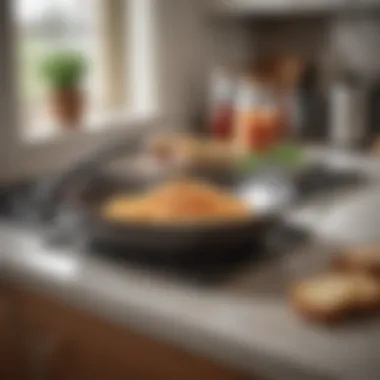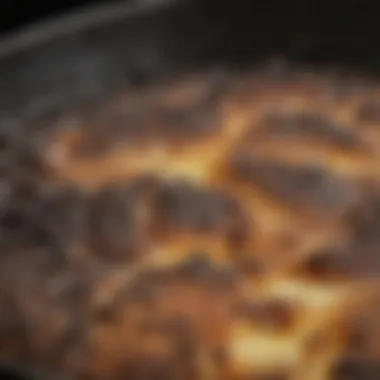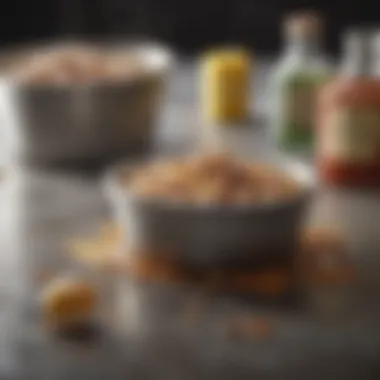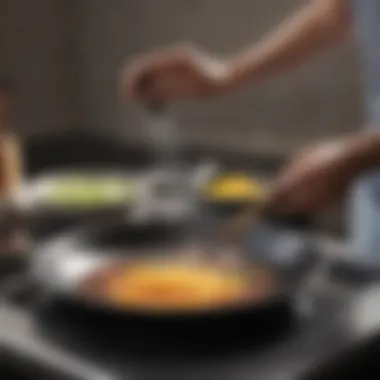Effective Strategies for Cleaning Greasy Pans


Intro
In the realm of culinary arts, maintaining the condition of your cookware is essential. Among these, greasy pans frequently challenge both novice and seasoned cooks alike. An effective approach to cleaning greasy pans can save time and extend the life of your kitchenware. This article discusses strategies and techniques that cater to different pan materials and grease levels. Understanding the most suitable tools and agents is crucial to restoring your pans to their original luster quickly and efficiently.
Cleaning greasy pans is not merely a routine chore; it requires intentionality and knowledge of what methods yield the best outcomes considering your specific situation. By employing the right strategies, you can ensure your pans remain in optimal condition, allowing for seamless transitions between meals without the burden of persistent grease.
From cast iron skillets to non-stick pans, each material possesses unique cleaning needs, further complicating the task. This article will serve as a comprehensive guide to managing such tasks in the kitchen. We will explore the best practices, tools, and techniques that make the process not just easier but also more effective, allowing you to return to cooking faster.
Understanding Grease Buildup
Cleaning greasy pans efficiently begins with understanding the nature of grease itself. Grease buildup is not just a cosmetic problem; it can affect cooking performance, alter flavors, and even increase health risks by harboring bacteria. A clear grasp of how and why grease accumulates on different cookware will enable users to select the most effective cleaning strategies.
Types of Grease
Grease can be categorized into several types based on its origin and composition. The most prominent types include:
- Animal Fats: These fats commonly come from meats, such as bacon or chicken. They tend to solidify when cooled, creating stubborn residue on pans.
- Plant Oils: Oils such as olive and canola are often used for cooking. They can break down under high heat, leading to sticky, greasy surfaces.
- Synthetic Oils: Present in some pre-packaged foods and snacks, these can create a complex cleaning challenge due to their chemical properties.
Recognizing these different types of grease is crucial for choosing the right cleaning agent.
Common Causes of Grease Accumulation
Grease accumulation on pans occurs through everyday cooking practices. Here are some common causes:
- High-Heat Cooking: When pans are heated excessively, oils can degrade and bond with the surface, leading to more difficult cleaning.
- Infrequent Cleaning: Allowing grease to build up without regular cleaning makes removal increasingly challenging. Neglecting maintenance can lead to layers of hardened gunk.
- Wrong Utensils: Using metal utensils on non-stick pans may scratch the surface, causing oils to adhere more stubbornly.
Understanding these causes helps in implementing preventive measures and choosing the correct cleaning methods, ultimately leading to a cleaner kitchen and enhanced cooking experiences.
Preparation for Cleaning
Preparation is a crucial step in the cleaning process of greasy pans. A well-planned approach ensures that the task is efficient, effective, and less time-consuming. By organizing your tools and resources beforehand, you can minimize frustration and achieve the best results. This preparation not only enhances the cleaning process but also protects the integrity of the pans being cleaned.
When you prepare for cleaning, consider the amount of grease and the type of pan you are dealing with. This understanding informs your choice of cleaning agents and techniques. It also sets the stage for a smoother experience, allowing you to tackle any unexpected challenges that come your way.
Moreover, gathering all necessary items in advance reduces interruptions during the cleaning process. It's essential to approach this task with a clear plan to avoid unnecessary back-and-forth movements that waste time. A comprehensive preparation phase can lead to a satisfying outcome and extend the lifespan of your pans.
Essential Tools and Materials
To effectively clean greasy pans, a selection of essential tools and materials must be at hand. Here are some key items:
- Sponges or Cloths: Soft sponges protect the surface of your pans while removing grease.
- Scrub Brushes: Particularly for stubborn residue in cast iron pans, a brush helps scrape without damaging.
- Baking Soda: This natural abrasive is effective for lifting grease without harsh chemicals.
- Vinegar: A powerful agent that can tackle oxidation and enhance cleaning capabilities when mixed with water.
- Dish Soap: A basic yet essential product for everyday cleaning of greasy surfaces.
- Hot Water: Having hot water ready can aid in breaking down grease faster.
- Safety Gloves: Protecting your skin from cleaning solutions is vital.
Make sure to have these tools ready before getting started. Having everything in place facilitates a more organized and efficient cleaning process.
Safety Precautions
When cleaning greasy pans, certain safety precautions must be adhered to. These measures are necessary not just for personal safety, but also for the effective handling of cleaning agents.
- Wear Gloves: Using gloves protects both your hands from harsh detergents and provides a better grip during scrubbing.
- Ventilate the Area: Open windows or use a fan to ensure proper airflow, especially when using cleaning chemicals.
- Read Labels: Always check the instructions on cleaning products to avoid harmful reactions, especially when mixing substances.
- Keep Tools and Cleaners Away from Heat: Never store cleaning products near hot appliances to prevent accidents.
- Handle Sharp Objects Cautiously: If using tools like scrub brushes with stiff bristles, pay attention to avoid cuts.
Implementing these safety measures contributes to a worry-free cleaning experience. It helps to maintain a focus on achieving a clean result without personal risk.
Cleaning Techniques for Different Pan Types
Understanding the different cleaning techniques for various pan materials is crucial. Each type of pan requires specific methods to effectively remove grease without causing damage. Using the appropriate cleaning technique can extend the life of the pan and maintain its appearance and functionality.


Stainless Steel Pans
Using Baking Soda
Baking soda is a versatile cleaning agent. It excels in removing stubborn grease from stainless steel pans. This fine powder acts as a gentle abrasive, helping to lift deposits without scratching the surface. When mixed with a small amount of water, it forms a paste that can be applied directly to greasy areas.
The benefits of using baking soda include its availability and non-toxic nature. It is also cost-effective, making it a popular choice among many home cooks. However, one should be cautious. Although it is safe for most surfaces, too much scrubbing may still cause wear on softer finishes.
Vinegar and Water Mixture
A mixture of vinegar and water offers another effective cleaning option. Vinegar is acidic, which helps break down grease and removes stains. The mixture can be sprayed directly onto the greasy pan, allowing it to sit for a few minutes for better penetration.
This method is beneficial because it provides a natural solution without harmful chemicals. The unique characteristic of this mixture is its deodorizing effect. However, vinegar may leave a smell until fully rinsed. Rinsing with water is essential to ensure no residue remains after cleaning.
Non-Stick Pans
Avoiding Abrasives
When cleaning non-stick pans, avoiding abrasive materials is vital. These surfaces are coated to prevent sticking, and any abrasive scrubbing can damage the coating. Using non-scratch sponge cloths or soft brushes is recommended to maintain the pan's integrity.
This approach is significant because it helps prolong the life of the non-stick surface, ensuring cooking remains efficient. The key characteristic of this method is its gentleness. However, it may require more time to remove tough stains, which can be seen as a drawback for some.
Gentle Cleaning Solutions
Alternatives like gentle liquid dish soap can aid in cleaning non-stick pans. Applying a small amount of this soap with warm water can effectively lift grease without harming the finish. This method promotes consistent maintenance of the pan’s surface.
The advantage of using gentle cleaning solutions lies in their ability to preserve the non-stick coating while still delivering effective cleaning results. Nonetheless, while it is mild, it may not be sufficient for extremely greasy pans. Sometimes, additional effort may be needed to achieve a clean result.
Cast Iron Pans
Hot Water Rinse
A hot water rinse is often sufficient for cast iron pans. This technique utilizes heat to help loosen stuck-on grease. After cooking, it’s advisable to rinse the pan with hot water while it is still warm. This can usually get rid of most residues without needing additional cleaning agents.
The main benefit of this method is its simplicity. It requires no specialized products, making it accessible to anyone. Care must be taken, though; if the pan is left to cool down, the grease can solidify, making cleaning more difficult.
Using Salt as an Abrasive
Using salt as an abrasive is a traditional technique for cast iron cleaning. Combining coarse salt with a small amount of water or oil creates a scrubbing solution. This approach effectively scrapes off stubborn residues without damaging the pan’s seasoning.
This method is valued for its effectiveness without the need for chemicals. Salt is a natural abrasive and usually readily available in most kitchens. However, overuse can wear down the seasoning of the cast iron if not rinsed properly afterward. Proper care is mandatory to ensure the pan stays in good condition.
Step-by-Step Cleaning Process
Understanding the step-by-step cleaning process is crucial for maintaining the functionality and appearance of greasy pans. It provides a clear roadmap for tackling a common household challenge. Each stage of the cleaning process ensures that grease and residue are effectively removed, which not only restores the pans but also enhances their lifespan. Moreover, following a structured cleaning method reduces the risk of damaging the pan material, especially with sensitive types like non-stick and cast iron. Here, we break down the significant components of the cleaning process, allowing culinary enthusiasts to engage with their tools more effectively.
Initial Rinse and Scrape
Before applying any cleaning agents, it is vital to perform an initial rinse on the pan. This step helps to remove loose debris, food particles, and surface grease. Use warm water to assist in loosening the residue. A gentle scrape with a silicone spatula or wooden spoon can dislodge stubborn bits without scratching the surface. This pre-cleaning action sets the foundation for the subsequent steps, ensuring that cleaning agents can penetrate any remaining greasy layers more efficiently. Avoid metal utensils, as they can harm the finish of the pan.
Applying Cleaning Agent
Once the initial rinse is complete, it is time to apply the appropriate cleaning agent. Select a cleaner that suits the pan's material. For stainless steel, you might choose vinegar mixed with water or a baking soda paste. Non-stick surfaces benefit from gentle dish soap, while cast iron pans can be treated with hot water and a sprinkle of coarse salt. Ensure the cleaner is evenly spread over the surface, allowing it to sit for a few minutes. This wait time enables the cleaning agent to break down grease more effectively, making future scrubbing easier.
Scrubbing Techniques


Scrubbing is where the cleaning becomes more active, and the type of scrubber used will depend on the pan's material. For stainless steel, use a non-abrasive sponge or a soft bristle brush. In contrast, non-stick pans require a soft cloth or sponge to avoid scratching, while cast iron is best scrubbed with a mix of salt and a stiff brush.
Maintain consistent pressure without exerting too much force to avoid damaging the pan's surface. Combine circular motions and back-and-forth strokes to cover every area, ensuring that the greasy spots receive extra attention. This meticulous approach results in a thorough cleanse, removing ingrained grease that simpler methods might overlook.
Final Rinse and Drying
After scrubbing, the final rinse is critical to wash away any remaining cleaning agents and dislodged residue. Use warm water again, ensuring that all soap or cleaning agent is removed. Once rinsed, dry the pan promptly with a soft towel. This step is particularly important for cast iron pans, as moisture can lead to rusting. For stainless steel and non-stick pans, drying immediately prevents water spots and streaks. Taking these finishing steps guarantees that the pan is not only clean but also ready for the next cooking venture.
Remember: Prompt cleaning after each use can significantly reduce the buildup of grease and make future cleaning easier.
Dealing with Stubborn Residue
Dealing with stubborn residue on greasy pans is essential for maintaining the quality and lifespan of cookware. When grease hardens or burns, it can become exceptionally difficult to clean. Neglecting this can lead to permanent damage or lead to food sticking during later use. Understanding how to effectively tackle this issue ensures your pans remain functional and clean, contributing to a better cooking experience.
Soaking Solutions
Soaking solutions are among the most effective ways to loosen tough residues on greasy pans. The method primarily relies on moisture and heat to soften built-up grease. Here’s how to implement it:
- Fill the Pan: Use hot water to fill the greasy pan, about three-quarters full.
- Add Cleaning Agents: Incorporate a suitable soaking agent. This could be dish soap or a specialized grease-fighting cleaner. Products like Dawn dish soap can be very effective.
- Let It Soak: Allow the pan to soak for at least 30 minutes, or longer for extremely stubborn grease. The heat from the water will loosen the residue.
- Scrub and Rinse: Following soaking, use a non-abrasive sponge or cloth to scrub the surface gently. Rinse thoroughly with warm water.
This method not only makes it easier to wipe off the grease but also avoids the need for aggressive scrubbing that may damage the pan.
Re-cooking Method
The re-cooking method is another effective strategy for dealing with stubborn residue. It involves using the natural cooking process to assist in cleaning. This may sound unconventional, but it has proven successful for many culinary enthusiasts. Here’s how to execute this method:
- Prepare the Pan: If the pan has remaining food particles and grease, add a small amount of water along with a bit of vinegar or baking soda.
- Heat the Pan: Place the pan back on the stove and heat it over low to medium heat. As the water begins to steam, it will help loosen the residue.
- Scrape Gently: Use a wooden spatula to scrape the bottom while the pan is on heat. The steam created will assist in lifting off the stubborn residues.
- Cool and Clean: Once the cleaning process is complete, let the pan cool before washing it as per normal cleaning guidelines.
Employing either of these methods can go a long way in restoring your greasy pans to their original state. Professionals often recommend these solutions due to their effectiveness and simplicity, promoting a practical approach to kitchen maintenance.
"Proper care and cleaning of cookware can extend its life and improve its performance."
Preventive Measures
Taking preventive measures to keep greasy pans from accumulating stubborn grime is essential in maintaining their condition and ensuring efficient cleaning. The focus is on implementing specific cooking techniques and establishing a regular maintenance routine. These strategies not only save time but also prolong the lifespan of your cookware.
Proper Cooking Techniques
A few adjustments in your cooking methods can make a noticeable difference in grease buildup on pans. Here are some key tips to consider:
- Use Appropriate Heat Levels: Cooking at excessively high temperatures can cause food to stick and burn. Aim for medium heat settings to prevent oil from splattering too much, which can lead to greasy surfaces.
- Oil Application: When using oil, apply just enough to coat the pan lightly. Excess oil is often a primary contributor to grease accumulation.
- Covering While Cooking: Using lids or splatter guards during cooking can significantly reduce grease splatter. This simple action keeps the surrounding areas cleaner, including your pans.
- Choose the Right Cookware: Selecting non-stick or easy-clean cookware can help minimize the problem. These materials often require less oil and are easier to clean afterward.
Adapting these cooking techniques will not only keep your pans cleaner but also enhance overall meal preparation.
Regular Maintenance
Establishing a routine for maintaining your cookware is crucial. Regular inspection, cleaning, and care can prevent grease buildup and extend your pans' life. Consider the following points:
- Immediate Cleaning: Cleaning pans immediately after use can prevent grease from hardening. A simple rinse or wipe down after cooking saves more extensive scrubbing later.
- Season Cast Iron Pans: For cast iron cookware, proper seasoning forms a protective layer. This layer helps resist buildup and provides a non-stick surface.
- Avoid Dishwasher Use: For certain materials, such as cast iron or non-stick pans, avoid using a dishwasher. The harsh detergents and high heat can damage these surfaces.
- Inspect for Damage: Regularly checking your pans for scratches or wear ensures they remain safe and effective for cooking. Address any damage promptly to avoid further issues.
Adhering to a regular maintenance schedule will keep your pans functional and reduce the need for intensive cleaning methods.
Alternative Cleaning Strategies
Cleaning greasy pans can sometimes require creative solutions. This section will delve into alternative cleaning strategies that can yield effective results. By exploring both natural cleaning agents and commercial cleaners, individuals can find methods that suit their preferences and needs.


Natural Cleaning Agents
Natural cleaning agents offer a gentler approach to removing grease without harsh chemicals. They are often more accessible and environmentally friendly. Two popular options include lemon juice and baking soda paste.
Lemon Juice
Lemon juice stands out for its acidity, which can help break down grease and food residues on pans. It is a beneficial choice because it is readily available in most kitchens and has a fresh scent.
One unique feature of lemon juice is its natural antibacterial properties. This means that using it for cleaning not only targets grease but also reduces bacterial presence. However, while lemon juice is effective on lightweight grease, it may require multiple applications for heavier buildup.
Overall, lemon juice serves as a valuable tool in the cleaning arsenal, especially for those who prefer gentle, natural solutions.
Baking Soda Paste
Baking soda paste is another effective natural cleaning agent. Made by mixing baking soda with water, it forms a thick paste that can adhere to greasy spots. This is significant because it allows for targeted cleaning of stubborn residues.
The key characteristic of baking soda is its mildly abrasive nature, which can help lift grease without scratching the surface of the pan. One of its advantages is versatility; it can be used on different materials, including stainless steel and non-stick pans. However, caution is needed with delicate finishes, as it may cause damage if used too vigorously.
Commercial Cleaners
Commercial cleaners are specially formulated products designed to tackle tough grease and grime. They often contain powerful chemicals that can break down grease effectively. While these products can be advantageous due to their strength, attention to user instructions is critical.
The main benefit of commercial cleaners lies in their speed and convenience. A simple spray and wipe can yield immediate results. Yet, users should be mindful of the materials used in their pans. Certain cleaners may not be suitable for all surfaces, particularly non-stick or cast iron. Therefore, it's important to choose the right product based on the type of pan and the manufacturer's recommendations.
In summary, whether opting for natural solutions or commercial products, alternative cleaning strategies offer diverse benefits for maintaining pans. Each method has its unique features, allowing cooks to tailor their approach to their specific needs.
Maintaining the Pan's Integrity
Maintaining the integrity of your cooking pans is essential for their longevity and performance. The term integrity refers not only to the physical condition of the pan but also to its functional aspects. By ensuring that pans are well cared for, you preserve their non-stick surfaces, prevent warping, and avoid chemical leaching, which can negatively affect food quality. Taking the time to maintain your cookware can save both costs and time in the long run.
Avoiding Common Mistakes
When it comes to cleaning and maintaining pans, certain common mistakes can significantly shorten their lifespan or diminish their effectiveness. Here are some pitfalls to avoid:
- Using Abrasive Tools: It may be tempting to scrub with steel wool or harsh scrubbers, but these can scratch non-stick and stainless steel surfaces.
- Overheating: High temperatures can warp pans, especially non-stick and cast iron types. Always follow the manufacturer's guidelines for heat levels.
- Neglecting to Dry: After cleaning, it's essential to dry pans promptly. This prevents water spots and rust, particularly on cast iron.
- Improper Storage: Stacking pans without protection can lead to scratching. Consider using pan protectors or separating them with cloth.
"The longevity of cookware directly correlates with the care it receives. Understanding how to properly maintain pans is as crucial as the cooking skills one might acquire."
Restoring Condition after Cleaning
After cleaning a pan, it is equally important to restore its condition to ensure optimal performance going forward. Here are some strategies:
- Seasoning Cast Iron: For cast iron pans, seasoning is key to enhancing the non-stick layer and preventing rust. Apply a thin layer of vegetable oil to the surface and heat it in the oven at the desired temperature to create a protective layer.
- Reconditioning Non-Stick Surfaces: If a non-stick pan has lost its effectiveness, consider using a small amount of oil on the surface during cooking to restore some function. If the surface is permanently damaged, replacement may be necessary.
- Polishing Stainless Steel: Clean stainless steel pans regularly with vinegar and water to enhance shine and prevent tarnishing. A gentle polishing with baking soda can restore their luster.
Through careful maintenance and restoration, you can ensure that your cookware serves its purpose efficiently while lasting many years. Each type of pan requires specific care, but with the right knowledge, you can keep your cookware in excellent shape.
The End
In this article, we explored the essential strategies for cleaning greasy pans, emphasizing the balance between effectiveness and care for different materials. Recognizing how grease buildup occurs and implementing appropriate techniques ensures that culinary enthusiasts maintain their cookware in optimal condition. The insights offered in the earlier sections emphasized tailored cleaning processes, considering the nature of the pan and the stubbornness of residue.
Summarizing Key Takeaways
- Understanding Grease Types: Different pans accumulate grease in unique ways. Identifying the type of grease can significantly impact cleaning success.
- Preparation is Key: Having the right tools and cleaning agents ready before starting the cleaning process streamlines effort and improves outcomes.
- Tailored Techniques: Using specific cleaning methods depending on the type of pan—such as stainless steel, non-stick, or cast iron—is crucial to avoid damaging the surface.
- Immediate Action: Addressing grease buildup promptly prevents the residues from hardening, making the cleaning process less labor-intensive.
- Stubborn Residue Solutions: Utilizing soaking solutions or the re-cooking method can effectively deal with those challenging residues that resist standard cleaning.
By keeping these points in mind, readers can enhance their cleaning routines, prolonging the lifespan of their cookware.
Encouragement for Ongoing Maintenance
Regular maintenance is fundamental. A proactive approach can minimize grease accumulation. Here are some practical strategies:
- Routine Cleaning: Establish a cleaning regimen after each use. A quick wipe down can stop grease from setting.
- Proper Cooking Techniques: Lowering cooking temperatures and using adequate cooking oils can reduce the amount of grease that adheres to pans.
- Regular Inspections: Make it a habit to check pans for buildup periodically. Early intervention can prevent extensive cleaning later.
- Use of Protective Gear: Employ splatter guards while cooking; this simple step can significantly reduce grease escape.
By adopting these practices, you foster not only a cleaner cooking environment but also extend the durability and performance of your pans. Embracing ongoing maintenance creates a more enjoyable culinary experience.







